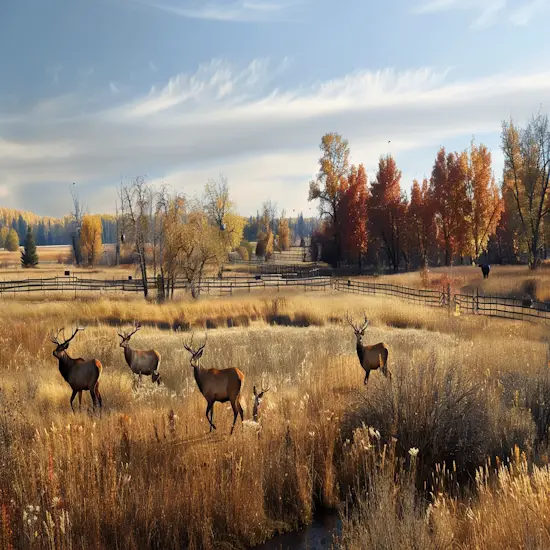Disclosure: We may earn commissions if you purchase products after clicking on a link from our site.
Deer population management is essential for the conservation of wildlife and the hunting environment. To manage deer populations effectively, consider carrying capacity essential. Keeping deer around 50% capacity boosts productivity.
Forest thinning, growing and maintaining food plots, and doe removal are some of the methods used in deer population management. In this article, we discuss deer population management and the methods used to accomplish it.

Table of Contents
- 1 Key Takeaways
- 2 Carrying Capacity and Population Sustainability
- 3 Recruitment Rate and Growth Dynamics
- 4 Reproductive Potential and Deer Management
- 5 Habitat Enhancement for Deer Population
- 6 Sustainable Yield and Harvest Optimization
- 7 Balancing Quantity and Quality in Herd
- 8 Effective Management Strategies for Deer
- 9 Ecological and Recreational Considerations
- 10 The Bottom Line
Key Takeaways
- Balancing the deer population around 50% of carrying capacity maximizes productivity.
- Strategic removal of does can enhance herd reproductive potential.
- Habitat quality improvement through forest thinning and food plots is vital.
- Monitoring recruitment rates ensures sustainable deer population dynamics.
- Maintaining a balance between deer population, habitat health, and sustainable harvest is essential.

Carrying Capacity and Population Sustainability
Understanding the carrying capacity of an area is vital in managing deer populations effectively. Factors like weather and human activity can impact the sustainability of deer populations. Striking a balance to maintain a healthy deer population is key for long-term success in wildlife management.
Carrying Capacity Importance
To maintain a balanced deer population that benefits both wildlife and habitat, it’s essential to take into account the carrying capacity of the area for sustainable deer management practices. Carrying capacity (K) is the maximum number of animals an area can support without habitat degradation.
External factors like weather and human interference can impact population sustainability. The recruitment rate is influenced by population density and affects population growth. Keeping the deer population around 50% of the carrying capacity (K) maximizes productivity.
Removing female deer increases the reproductive potential of the herd. Striking a balance between the deer population and carrying capacity through management techniques is vital for long-term success in maintaining a healthy deer population and habitat.
Population Sustainability Factors
Building upon the importance of carrying capacity for sustainable deer management, the key factor in ensuring population sustainability is maintaining a balance between deer numbers and habitat health.
It’s vital to keep the deer population at around 50% of the carrying capacity to maximize productivity. By removing does strategically, you can increase the reproductive potential of the herd. This trigger finger management approach can help restore the balance between the deer population and carrying capacity.
Enhancing habitat quality through steps like forest stand thinning and establishing food plots contributes to sustainable deer management. Achieving Optimum Sustainable Yield (OSY) at 60-70% of carrying capacity maximizes deer harvest and hunter satisfaction, ensuring a balance between deer population, habitat health, and sustainable harvest.

Recruitment Rate and Growth Dynamics
Understanding the growth rate impacts and recruitment dynamics is vital for evaluating population sustainability in deer management. Analyzing these factors allows you to make informed decisions on maintaining a balanced deer population.
Growth Rate Impacts
How do recruitment rate and growth dynamics impact the deer population’s growth rate? Understanding these factors is essential for managing deer populations effectively.
- High recruitment rates lead to a rapid increase in deer numbers.
- Growth dynamics influence how quickly the population expands.
- Low recruitment rates can slow down population growth.
- Managing recruitment and growth dynamics is vital for maintaining a balanced deer population.
Recruitment Dynamics Analysis
In analyzing deer recruitment dynamics, the rate at which new deer are added to the population directly impacts overall growth patterns. The density-dependent recruitment rate plays a vital role in determining the population’s sustainability.
When the recruitment rate is high, the deer population tends to grow rapidly, while a lower recruitment rate can lead to a more stable or declining population size. Maintaining the recruitment rate at an ideal level is essential for balancing the deer population with the available habitat resources.
Understanding these dynamics is key to implementing effective deer population management strategies. By monitoring and managing recruitment rates, you can help ensure a healthy and sustainable deer population in your area.
Population Sustainability Assessment
Evaluating the sustainability of a deer population involves examining the recruitment rate and growth dynamics to guarantee a balanced ecosystem. When appraising population sustainability, consider the following:
- Recruitment Rate: Monitoring the number of new deer added to the population annually.
- Growth Dynamics: Understanding how factors like food availability and predation impact the population size.
- Balanced Ecosystem: Ensuring that the deer population remains at a prime level to prevent overgrazing and maintain habitat health.
- Reproductive Potential: Managing the number of does to control the reproductive capacity of the herd.

Reproductive Potential and Deer Management
When managing deer populations, understanding female deer reproduction is vital. Various population control methods, such as hormonal manipulation techniques, can help regulate the deer population effectively.
Female Deer Reproduction
Understanding the reproductive potential of female deer is essential for effective deer management practices. Female deer play a vital role in the growth and sustainability of deer populations. Here are key points to keep in mind:
- Female deer reproductive rate varies based on age and health.
- Each female deer can give birth to one to three fawns per year.
- Fawns can start reproducing at around 1.5 years of age.
- The high reproductive potential of does can lead to rapid population growth if left unchecked.
Population Control Methods
To effectively manage deer populations, controlling their reproductive potential is an essential aspect of deer management practices. By focusing on regulating female reproduction, you can help maintain a balanced deer population.
Understanding the different seasons in deer biology that impact reproductive control methods is vital. Techniques such as immunocontraceptive vaccines and contra gestation agents can be used to manage deer populations effectively. Research on non-lethal methods targeting female deer is ongoing to find sustainable solutions.
It’s important to note that altering the reproductive potential of does can have a substantial impact on the overall deer herd. By utilizing these reproductive control methods, you can contribute to the long-term success of deer population management while ensuring the health of the ecosystem.
Hormonal Manipulation Techniques
Controlling the reproductive potential of female deer is key to effectively managing deer populations and ensuring long-term sustainability.
When it comes to hormonal manipulation techniques, consider the following:
- Administering immunocontraceptive vaccines to control deer reproduction.
- Using contragestation agents to prevent fetal development in female deer.
- Researching non-lethal methods targeting female deer for population control.
- Implementing strategies that focus on manipulating the hormonal balance in female deer to achieve desired population levels.

Habitat Enhancement for Deer Population
To enhance the habitat for deer, focus on improving the quality of their surroundings. This can be achieved by creating sustainable food sources and developing a wildlife-friendly landscape. Enhancing habitat quality benefits not only the deer population but also other wildlife species in the ecosystem.
Habitat Quality Improvement
Enhancing deer habitat quality is crucial for maintaining a balanced and healthy deer population.
- Forest Stand Thinning: Clearing out dense areas in the forest to allow for better vegetation growth and easier movement for deer.
- Establishing Food Plots: Planting specific areas with deer-friendly vegetation to provide additional food sources.
- Water Source Creation: Installing water stations or maintaining natural water sources to guarantee deer have access to clean drinking water.
- Shelter Enhancement: Adding brush piles or creating dense vegetation areas to offer cover and protection for deer during harsh weather conditions.
Sustainable Food Sources
Improving the availability of nutritious food sources is essential for maintaining a healthy and balanced deer population. Enhancing the habitat by planting food plots rich in essential nutrients can help support deer health and reproduction.
By providing a diverse range of vegetation such as clover, alfalfa, and other deer-preferred plants, you can guarantee that the deer have access to the necessary food resources to thrive. Additionally, managing the habitat to promote the growth of these food sources can contribute to sustainable deer population management.
Ensuring a consistent and reliable food supply throughout the year can help prevent overpopulation and maintain a harmonious balance between the deer population and their habitat.
Wildlife-Friendly Landscape
Promoting a diverse range of vegetation in your habitat can support the health and reproduction of deer populations. To create a wildlife-friendly landscape, consider the following:
- Plant native grasses and shrubs to provide food and cover for deer.
- Create water sources like small ponds or birdbaths to attract deer.
- Implement natural barriers such as hedges or rock piles to offer protection.
- Avoid using pesticides and herbicides to maintain a safe environment for deer.

Sustainable Yield and Harvest Optimization
To optimize deer harvest and maintain a sustainable yield, you need to contemplate strategies that balance the deer population and enhance their habitat.
By managing the deer population effectively, you can guarantee the health of both the wildlife and their environment. Implementing habitat improvement techniques and sustainable harvest practices are key to achieving these goals.
Harvest Sustainability Methods
For effective deer population management, understanding harvest sustainability methods like sustainable yield and harvest optimization is essential. Here’s a brief overview to help you grasp these concepts:
- Sustainable Yield
- Balancing deer numbers with available resources.
- Ensuring long-term deer population health.
- Maximizing productivity while preserving the ecosystem.
- Achieving a sustainable harvest rate.
Habitat Enhancement Techniques
Enhancing deer habitat through strategic improvements can maximize sustainable yield and optimize harvest methods for effective population management.
- Forest Stand Thinning: Removing excess trees to create open spaces for deer grazing and browsing.
- Establishing Food Plots: Planting specific crops to provide additional food sources for deer.
- Creating Water Sources: Installing watering holes or maintaining streams to guarantee deer have access to water.
- Implementing Shelter Enhancements: Adding brush piles or dense vegetation areas for deer to seek refuge and bedding sites.

Balancing Quantity and Quality in Herd
When managing your deer population, it’s vital to balance the quantity and quality of the herd. This means considering factors like herd size management, maintaining ecological balance, and ensuring sustainability in deer populations.
Herd Size Management
Maintaining a balanced deer herd involves carefully managing both quantity and quality to guarantee long-term sustainability and health.
- Balancing Quantity and Quality
- Monitor deer population size and health indicators regularly.
- Adjust hunting quotas based on population estimates and habitat conditions.
- Consider the age and sex ratio within the herd for genetic diversity.
- Implement habitat improvements to support a healthy and sustainable deer population.
Ecological Balance Maintenance
To maintain a healthy deer population, it’s essential to carefully manage the balance between quantity and quality within the herd. Keeping the right number of deer while ensuring their overall health and genetic diversity is critical.
By controlling the deer population around 50% of the carrying capacity, you can maximize productivity and maintain a sustainable ecosystem. Removing does can increase the reproductive potential of the herd, contributing to a more balanced population.
Balancing the quantity and quality of deer can be challenging but is important for the long-term success of the ecosystem. Habitat improvements, such as forest stand thinning and establishing food plots, play a significant role in maintaining this delicate balance.

Effective Management Strategies for Deer
When managing deer populations, it’s important to focus on:
- Habitat enhancement techniques, such as forest stand thinning and establishing food plots, to restore balance in the deer population.
- Population control methods and sustainable harvesting practices. These are key components of successful deer management strategies.
Habitat Enhancement Techniques
Enhancing deer habitat involves improving the quality of their living environment through strategic management practices.
- Plant native vegetation to provide food sources.
- Create water sources like ponds or streams for hydration.
- Establish shelter areas such as thickets or brush piles for protection.
- Conduct forest stand thinning to enhance browse availability.
Population Control Methods
To effectively manage deer populations, implementing various control methods is essential for maintaining a balanced ecosystem. Regulated hunting remains the most common strategy for white-tailed deer control, but it has limitations in suburban areas.
Live capture and relocation, while costly, also pose risks with high mortality rates. Research is exploring non-lethal options that focus on controlling female deer reproduction using immunocontraceptives and contra gestation agents.
Sterilization techniques, particularly male removal, show promise due to low infection risks and permanence. However, measuring success rates and potential behavioral changes are challenges.
Future research emphasizes the development of long-term, sustainable population control methods to address deer-related issues like agricultural damage and collisions.
Sustainable Harvesting Practices
For effective deer population management, sustainable harvesting practices play an important role in maintaining a balanced ecosystem and ensuring long-term success.
When implementing sustainable harvesting practices, consider the following:
- Harvesting Limits: Set appropriate limits on the number of deer harvested to prevent overexploitation.
- Selective Harvesting: Target specific deer populations based on age and sex to maintain a healthy demographic structure.
- Habitat Preservation: Guarantee that harvesting practices don’t harm the natural habitat of deer and other wildlife.
- Monitoring and Adaptation: Continuously monitor deer populations and adjust harvesting practices accordingly to promote sustainability.

Ecological and Recreational Considerations
When managing deer populations, it’s crucial to contemplate habitat conservation strategies, wildlife population dynamics, and the impact of recreational hunting. Understanding how these factors interact can help create a balanced approach to deer population management that benefits both the ecosystem and recreational activities.
Habitat Conservation Strategies
Considering the importance of maintaining a balanced deer population that benefits both wildlife and habitat, implementing habitat conservation strategies is essential. When it comes to habitat conservation for deer, you should focus on:
- Enhancing habitat quality through forest stand thinning.
- Establishing food plots to provide additional food sources.
- Improving habitat can help restore balance in the deer population.
- Enhancing habitat quality benefits deer and other wildlife species.
Wildlife Population Dynamics
Improving wildlife population dynamics involves understanding both ecological and recreational aspects for effective management. Wildlife population dynamics are influenced by factors like habitat quality, food availability, and predation. Balancing deer numbers with habitat capacity is vital for sustainable populations.
Monitoring birth rates, death rates, and migration helps assess population health. Overpopulation can lead to habitat degradation, impacting other species. Deer management should consider recreational activities like hunting, which can help regulate populations.
Sustainable deer herds benefit ecosystems and provide recreational opportunities. Maintaining a balance that supports both wildlife diversity and human enjoyment of outdoor activities is crucial. Understanding these dynamics is key to successful deer population management.
Recreational Hunting Impact
To understand the impact of recreational hunting on both the environment and outdoor activities, it’s essential to contemplate the ecological and recreational implications of this practice.
Recreational hunting can have the following effects:
- Population Control: Hunting helps manage deer populations, preventing overgrazing and habitat degradation.
- Economic Benefits: Hunting supports local economies through tourism and equipment sales.
- Ecological Balance: Proper hunting practices can maintain a balanced ecosystem by controlling deer numbers.
- Outdoor Enjoyment: Hunting provides recreational opportunities, connecting individuals with nature and fostering conservation awareness.

The Bottom Line
To conserve wildlife and maintain the hunting environment, deer population management is important. Managing deer populations requires a delicate balance between conservation and control. By implementing sustainable practices and taking into account the needs of both humans and wildlife, you can guarantee a harmonious coexistence.
There are many strategies for deer population management including the removal of does, thinning forests, planting food plots, and more. In this article, we shared information about managing the deer population.
additionally, you can learn about deer hunting regulations and laws, deer hunting in different seasons, as well as the ethics and etiquette in deer hunting.